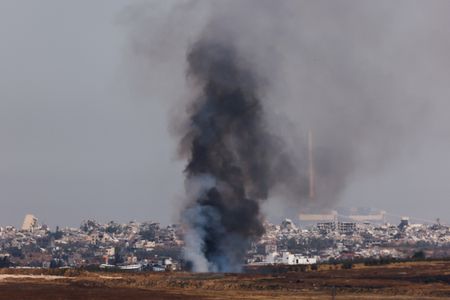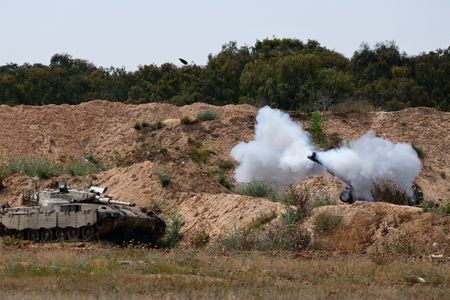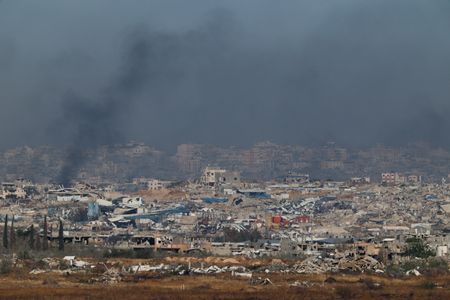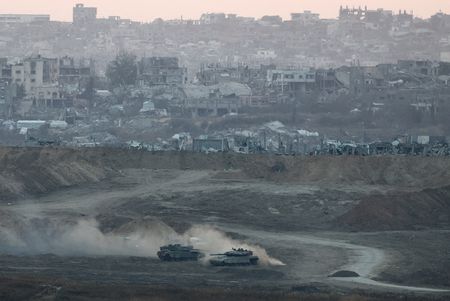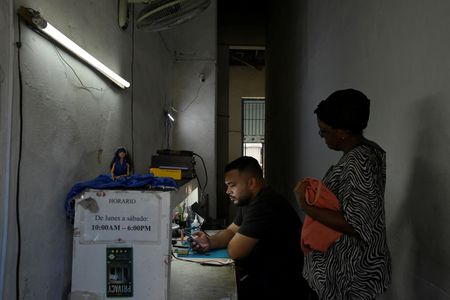By Nidal al-Mughrabi
CAIRO (Reuters) -Israel’s plan to expand its Gaza offensive, displace people within the enclave and take control of aid distribution has horrified Gazans who already have endured multiple displacements and food shortages during 19 months of conflict.
Israel has been blocking all aid from entering Gaza since March 2 with the collapse of a two-month ceasefire with Hamas that had improved Gazans’ access to food and medicine and allowed many of them to go home.
For Aya, a 30-year-old Gaza City resident who returned home with her family during the ceasefire after months in the southern part of the strip, Israel’s announcement on Monday raised fears of being killed or indefinitely displaced.
“Are we going to die this time?” she said in a message on a chat app.
“Are they going to displace us again? Are we going to end up in Rafah, and will this be the last time, or are they going to force us out of Gaza after Rafah?” she said, referring to the Rafah area in southern Gaza, next to Egypt’s border.
Attending a funeral on Monday for several people killed in an Israeli airstrike on a building in Gaza City, Mohammed al-Seikaly said things were so dire it was hard to imagine how Israel could further intensify its assault.
“There is nothing left in the Gaza Strip that has not been struck by missiles and explosive barrels,” he said. “I’m asking in front of the whole world: ‘What’s left to bomb?'”
On Tuesday, Israeli military strikes killed at least 46 Palestinians across Gaza, local health authorities said. Medics said at least 29 people, including women and children, were killed at a school housing displaced families in the Bureij camp in the central Gaza Strip.
Medics said the school was hit twice within a few hours.
After the first airstrike, the Israeli military said it had struck terrorists operating from a command center used for storing weapons and planning and staging attacks against Israel. There was no immediate army comment after the second attack.
Israeli Prime Minister Benjamin Netanyahu said the expanded military operation would be “intensive” and involve holding seized territories and moving Palestinians “for their own safety”.
DEARTH OF FOOD
One Israeli official said the plan would involve moving the civilian population southward and controlling aid distribution to prevent food from falling into the hands of Hamas, the Islamist militant group whose attack on Israel in October 2023 triggered Israel’s military operation in Gaza.
The United Nations Office for the Coordination of Humanitarian Affairs rejected the plan on Tuesday as “the opposite of what is needed”.
Tamer, a man from Khan Younis in the southern half of the Strip, said he feared Israel could impose its own triage system to decide who would get food.
“Will they arrest people and kill others before they let the rest into the areas they designate?” he said.
Gaza’s 2.3 million people are struggling with a dearth of food, with many eating only once a day. The World Food Programme said on April 25 it had run out of food stocks in the Strip.
Flour often can’t be found, but when a rare sack is available it can cost as much as $500, up from 25 shekels ($7) before the war, Aya said.
“They are starving us so we can agree to anything. We want an end to the war. Let them take their prisoners (Israeli hostages) and end the war. Enough,” she added.
Some residents have been eating weeds or leaves, while fishermen have turned to catching sea turtles and selling their meat.
Israeli officials have said there is still enough food in Gaza, though the head of Israel’s military has warned the political leadership that supplies must be let in soon, public broadcaster Kan reported.
Hamas, which has run Gaza since 2007, accuses Israel of “using food as a weapon in its war against the people of Gaza”.
The war began on October 7, 2023, when Hamas killed 1,200 people and took 251 hostage, according to Israeli tallies.
Israel’s campaign has killed more than 52,000 Palestinians, mostly civilians, according to Hamas-run health authorities, and reduced much of Gaza to ruins.
($1 = 3.6137 shekels)
(Reporting by Nidal al-Mughrabi; additional reporting by Dawoud Abu Alkas in Gaza; editing by Estelle Shirbon, Aidan Lewis and Gareth Jones)

